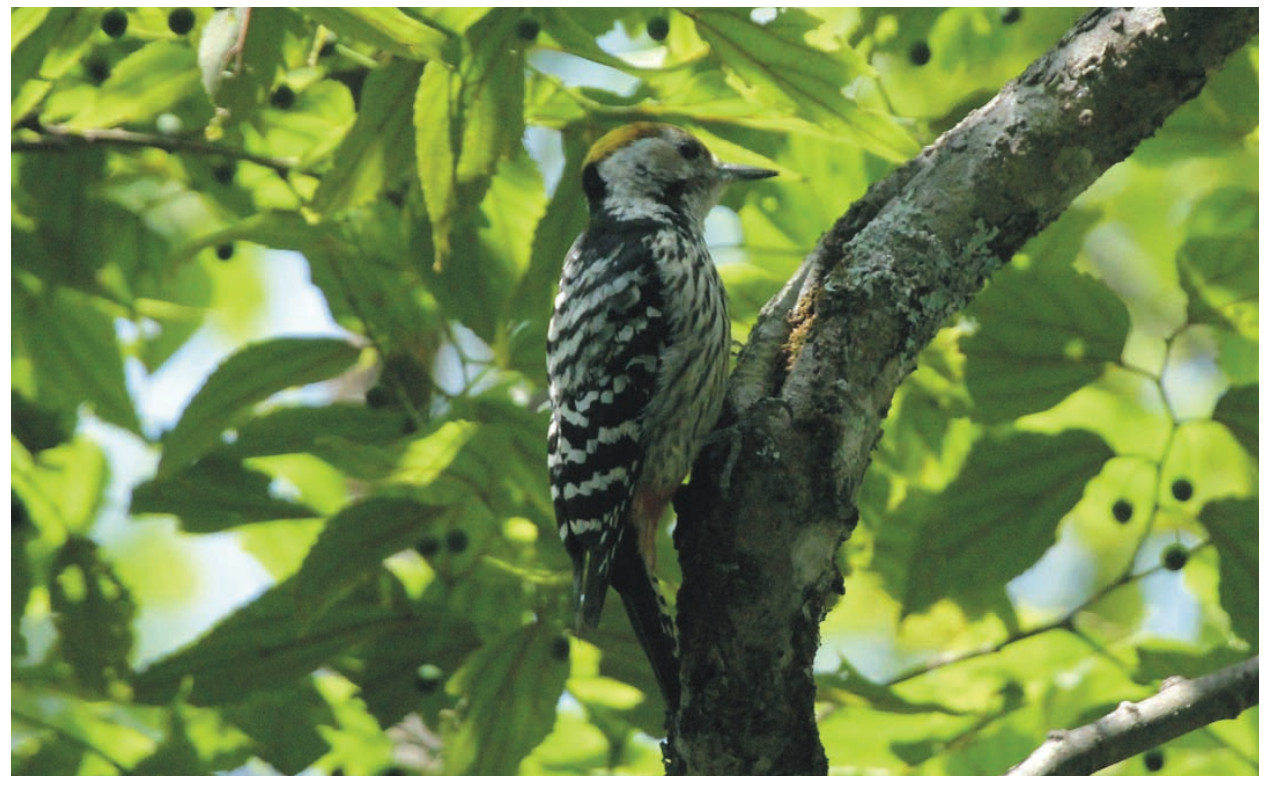
| Citation: | Jingjing LI, Hongfeng CAO, Kun JIN, Lianxian HAN, Huijian HU. 2012: A new record of Picidae in China: the Brown-fronted Woodpecker (Dendrocopos auriceps). Avian Research, 3(3): 240-241. DOI: 10.5122/cbirds.2012.0023 |
A female Brown-fronted Woodpecker (Dendrocopos auriceps) was first observed and photographed in the Jilong Valley of the Mount Qomolangma Region, China, on 21 May 2012. The coordinates of the site are 28°19'25.03″N, 85°20'29.70″E at an elevation of 2150 m. A few months later, a male was observed at 28°20'02.49″N, 85°20'46.30″E on 8 August at an elevation of 2197 m. The habitat is a mountain temperate coniferous and dry broadleaved mixed forest of the warm temperate zone.
On 21 May, 2012, a female Brown-fronted Woodpecker (Dendrocopos auriceps) was observed and photographed (Fig. 1) at 11:20 am in the Jilong Valley of the Mount Qomolangma Region, China. This is the first record in China of this bird (MacKinnon et al., 2000; Zheng, 2011). The coordinates of the site are 28°19′25.03″N, 85°20′29.70″E and its elevation is 2150 m. As well, at a distance of about 3 km, we sighted one male woodpecker at 11:08 on 8 August. The record site is 28°20′02.49″N, 85°20′46.30″E at an elevation of 2197 m.
From top to bottom, the biotope types of the Jilong Valley are subtropical evergreen broadleaved forests, temperate coniferous and broadleaved mixed mountain forests, cold-temperate coniferous mountain forests, subalpine shrubs and meadows, alpine cold meadow cushion vegetation and alpine cryic moraine lichen belts. The range in elevation of the temperate coniferous and dry broadleaved mixed forests in the mountains is between 1900 and 2200 m.
When we sighted the Brown-fronted female Woodpecker, she was foraging on a tree, a Celtis tetrandra, belonging to the Rhamnaceae family. The male was taking a break at a dead pine tree. The cover type is a mountain temperate coniferous and dry broadleaved mixed forest (mainly coniferous forest).
The morphological traits of the female are as follows: brownish forehead and crown, white-barred upperparts, prominent black moustachial stripe, a black stripe from the back of neck extending through to the dorsum, well-defined streaking on the underparts, pink undertail-coverts and unbarred central tail feathers (Fig. 1). The male has a distinct yellow central crown on his head, which is prominently different from the female.
It has been recorded as a resident in Afghanistan, India, Nepal and Pakistan. In Nepal, it is fairly common and widespread in coniferous and dry broadleaved mixed forests, ranging in elevation from 1065 to 2440 m. In Pakistan it is also resident but rare and uncommon (Raja et al., 1999; Grimmett et al., 2000; Girish and Asad, 2006; Darulaman, 2008). Because of a lack of more information, we may deduce that the Brown-fronted Woodpecker is found mainly in the valleys of southern exposed Himalayan slopes.
The elevations at which this species is found at Jilong are essentially the same as those in other countries. We assume it is also a resident species in Jilong because of its appearance at this season. We believe more individuals and nests will be found after further surveys and searches.
We are grateful to Prof. Zhang Zhengwang who works in Beijing Normal University for verifying the new record. We thank Prof. Xie Qiang who works in Guangxi Normal University for identifying the broadleaved trees.
|
Darulaman. 2008. Biodiversity Profile of Afghanistan. United Nations Environment Programme Press, Kabul, Afghanistan.
|
|
Girish AJ, Asad RR. 2006. Endemic Birds of India. Buceros, 11(2–3): 48–50.
|
|
Grimmett R, Inskipp C, Inskipp T. 2000. Birds of Nepal. Princeton University Press, Princeton and Oxford.
|
|
MacKinnon J, Phillipps K, He FQ. 2000. A Field Guide to the Birds of China. Hunan Education Press, Changsha, China. (in Chinese)
|
|
Raja NA, Davidson P, Bean N, Drijvers R, Showler DA, Barker C. 1999. The birds of Palas. North-West Frontier Province, Pakistan. Forktail, 15: 77–85.
|
|
Zheng GM. 2011. A Checklis on the Classification and Distribution of the Birds of China. Science Press, Beijing. (in Chinese)
|